check engine SAAB 9-5 2009 Owners Manual
[x] Cancel search | Manufacturer: SAAB, Model Year: 2009, Model line: 9-5, Model: SAAB 9-5 2009Pages: 272, PDF Size: 21.53 MB
Page 6 of 272
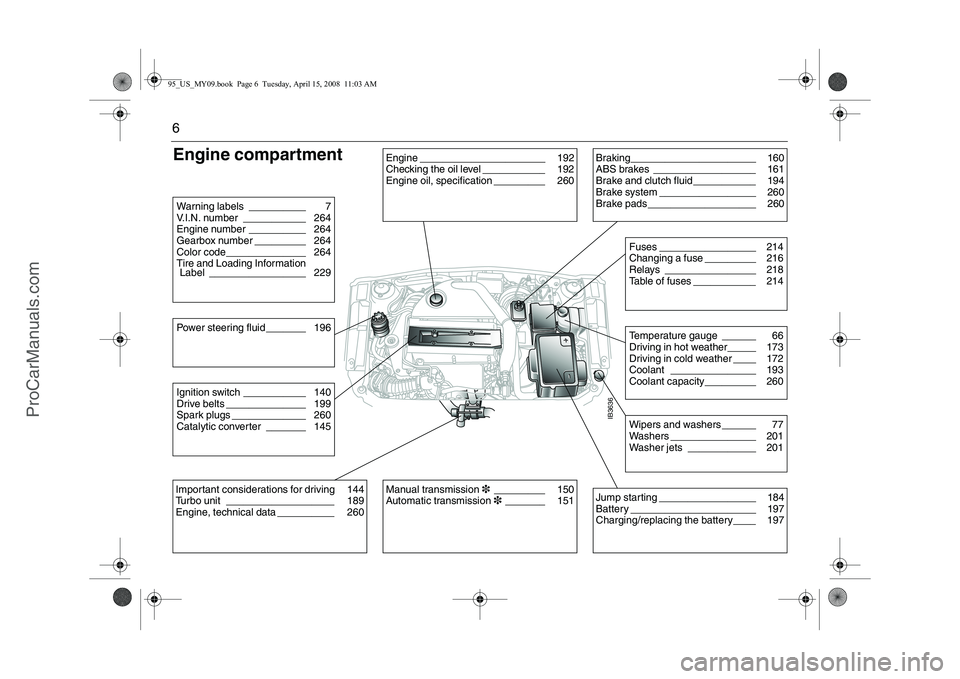
6Engine compartment
IB3636
Engine ______________________ 192
Checking the oil level ___________ 192
Engine oil, specification _________ 260
Braking______________________ 160
ABS brakes __________________ 161
Brake and clutch fluid ___________ 194
Brake system _________________ 260
Brake pads ___________________ 260
Fuses _________________ 214
Changing a fuse _________ 216
Relays ________________ 218
Table of fuses ___________ 214Temperature gauge ______ 66
Driving in hot weather_____ 173
Driving in cold weather ____ 172
Coolant _______________ 193
Coolant capacity_________ 260
Power steering fluid _______ 196
Wipers and washers ______ 77
Washers _______________ 201
Washer jets ____________ 201
Jump starting _________________ 184
Battery ______________________ 197
Charging/replacing the battery____ 197
Manual transmission3_________ 150
Automatic transmission3_______ 151
Important considerations for driving 144
Turbo unit ___________________ 189
Engine, technical data __________ 260Ignition switch ___________ 140
Drive belts ______________ 199
Spark plugs _____________ 260
Catalytic converter _______ 145Warning labels __________ 7
V.I.N. number ___________ 264
Engine number __________ 264
Gearbox number _________ 264
Color code______________ 264
Tire and Loading Information
Label _________________ 22995_US_MY09.book Page 6 Tuesday, April 15, 2008 11:03 AM
ProCarManuals.com
Page 51 of 272
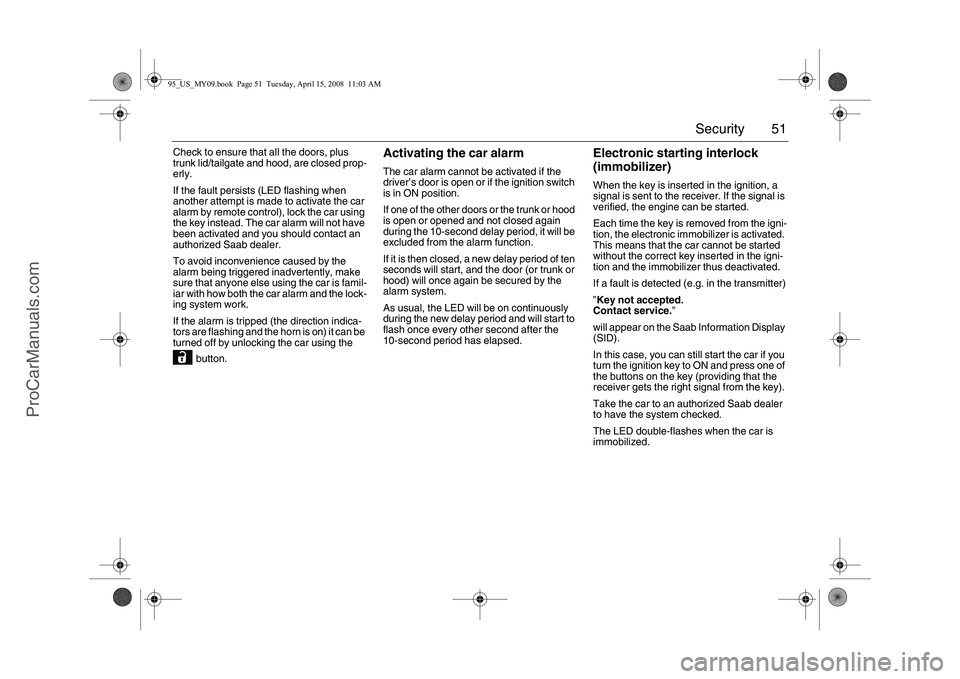
51 Security
Check to ensure that all the doors, plus
trunk lid/tailgate and hood, are closed prop-
erly.
If the fault persists (LED flashing when
another attempt is made to activate the car
alarm by remote control), lock the car using
the key instead. The car alarm will not have
been activated and you should contact an
authorized Saab dealer.
To avoid inconvenience caused by the
alarm being triggered inadvertently, make
sure that anyone else using the car is famil-
iar with how both the car alarm and the lock-
ing system work.
If the alarm is tripped (the direction indica-
tors are flashing and the horn is on) it can be
turned off by unlocking the car using the
button.
Activating the car alarm The car alarm cannot be activated if the
driver’s door is open or if the ignition switch
is in ON position.
If one of the other doors or the trunk or hood
is open or opened and not closed again
during the 10-second delay period, it will be
excluded from the alarm function.
If it is then closed, a new delay period of ten
seconds will start, and the door (or trunk or
hood) will once again be secured by the
alarm system.
As usual, the LED will be on continuously
during the new delay period and will start to
flash once every other second after the
10-second period has elapsed.
Electronic starting interlock
(immobilizer) When the key is inserted in the ignition, a
signal is sent to the receiver. If the signal is
verified, the engine can be started.
Each time the key is removed from the igni-
tion, the electronic immobilizer is activated.
This means that the car cannot be started
without the correct key inserted in the igni-
tion and the immobilizer thus deactivated.
If a fault is detected (e.g. in the transmitter)
”Key not accepted.
Contact service.”
will appear on the Saab Information Display
(SID).
In this case, you can still start the car if you
turn the ignition key to ON and press one of
the buttons on the key (providing that the
receiver gets the right signal from the key).
Take the car to an authorized Saab dealer
to have the system checked.
The LED double-flashes when the car is
immobilized.
95_US_MY09.book Page 51 Tuesday, April 15, 2008 11:03 AM
ProCarManuals.com
Page 54 of 272
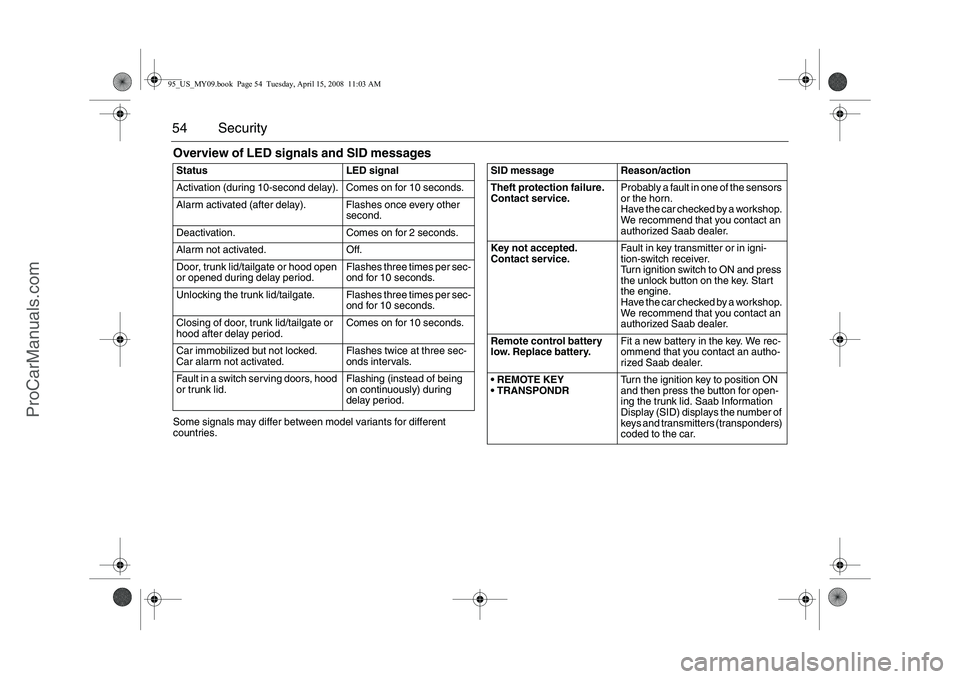
54 SecurityOverview of LED signals and SID messagesSome signals may differ between model variants for different
countries. Status LED signal
Activation (during 10-second delay). Comes on for 10 seconds.
Alarm activated (after delay). Flashes once every other
second.
Deactivation. Comes on for 2 seconds.
Alarm not activated. Off.
Door, trunk lid/tailgate or hood open
or opened during delay period.Flashes three times per sec-
ond for 10 seconds.
Unlocking the trunk lid/tailgate. Flashes three times per sec-
ond for 10 seconds.
Closing of door, trunk lid/tailgate or
hood after delay period.Comes on for 10 seconds.
Car immobilized but not locked.
Car alarm not activated.Flashes twice at three sec-
onds intervals.
Fault in a switch serving doors, hood
or trunk lid.Flashing (instead of being
on continuously) during
delay period.
SID message Reason/action
Theft protection failure.
Contact service.Probably a fault in one of the sensors
or the horn.
Have the car checked by a workshop.
We recommend that you contact an
authorized Saab dealer.
Key not accepted.
Contact service.Fault in key transmitter or in igni-
tion-switch receiver.
Turn ignition switch to ON and press
the unlock button on the key. Start
the engine.
Have the car checked by a workshop.
We recommend that you contact an
authorized Saab dealer.
Remote control battery
low. Replace battery.Fit a new battery in the key. We rec-
ommend that you contact an autho-
rized Saab dealer.
REMOTE KEY
TRANSPONDRTurn the ignition key to position ON
and then press the button for open-
ing the trunk lid. Saab Information
Display (SID) displays the number of
keys and transmitters (transponders)
coded to the car.
95_US_MY09.book Page 54 Tuesday, April 15, 2008 11:03 AM
ProCarManuals.com
Page 58 of 272

58 Instruments and controls
Indicator and warning
lights A number of indicator and warning lights will
come on when the ignition is switched on
prior to starting. Under normal conditions,
these should go out a few seconds after the
engine has started (see page 64).
Service Engine Light also
known as CHECK ENGINE
WARNING
An illuminated ”Service Engine Light also
known as CHECK ENGINE” indicator
light indicates an engine-related problem.
While your car may be able to be driven
with the ”Service Engine Light also known
as CHECK ENGINE” indicator light illumi-
nated (Limp-home mode), you are
advised to have your car serviced at an
authorized Saab dealer as soon as possi-
ble.
Continued driving without this problem
being corrected might cause serious fur-
ther damage to your car and create
unsafe driving conditions. The driver
should be prepared to take action if such
unsafe conditions arise (e.g.brake
smoothly, engage neutral, stop in a suita-
ble place, switch off the engine, etc.).
Main instrument panel 1 Tachometer
2 Indicator and warning lights
3 Speedometer
4 Indicator and warning lights
5 Pressure gauge 36 Fuel gauge
7 Engine temperature gauge
8 Odometer and trip meter
9 Trip meter reset button
IB4117
U.S. shown, Canada similar
95_US_MY09.book Page 58 Tuesday, April 15, 2008 11:03 AM
ProCarManuals.com
Page 59 of 272
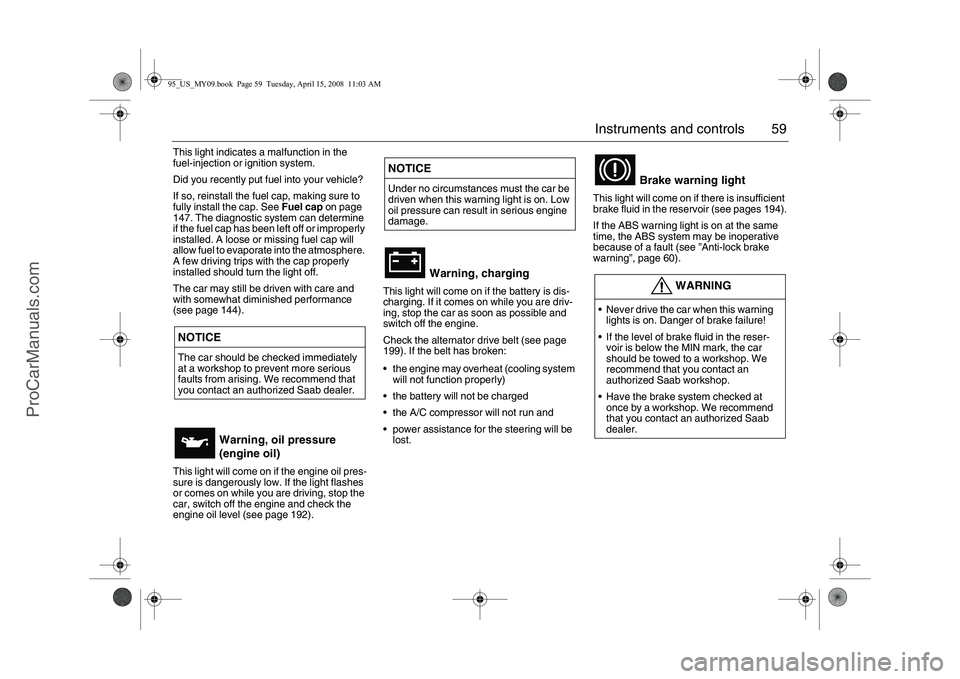
59 Instruments and controls
This light indicates a malfunction in the
fuel-injection or ignition system.
Did you recently put fuel into your vehicle?
If so, reinstall the fuel cap, making sure to
fully install the cap. See Fuel cap on page
147. The diagnostic system can determine
if the fuel cap has been left off or improperly
installed. A loose or missing fuel cap will
allow fuel to evaporate into the atmosphere.
A few driving trips with the cap properly
installed should turn the light off.
The car may still be driven with care and
with somewhat diminished performance
(see page 144).
This light will come on if the engine oil pres-
sure is dangerously low. If the light flashes
or comes on while you are driving, stop the
car, switch off the engine and check the
engine oil level (see page 192).
This light will come on if the battery is dis-
charging. If it comes on while you are driv-
ing, stop the car as soon as possible and
switch off the engine.
Check the alternator drive belt (see page
199). If the belt has broken:
the engine may overheat (cooling system
will not function properly)
the battery will not be charged
the A/C compressor will not run and
power assistance for the steering will be
lost.This light will come on if there is insufficient
brake fluid in the reservoir (see pages 194).
If the ABS warning light is on at the same
time, the ABS system may be inoperative
because of a fault (see ”Anti-lock brake
warning”, page 60).
NOTICEThe car should be checked immediately
at a workshop to prevent more serious
faults from arising. We recommend that
you contact an authorized Saab dealer.
Warning, oil pressure
(engine oil)
NOTICEUnder no circumstances must the car be
driven when this warning light is on. Low
oil pressure can result in serious engine
damage.
Warning, charging
Brake warning light
WARNING
Never drive the car when this warning
lights is on. Danger of brake failure!
If the level of brake fluid in the reser-
voir is below the MIN mark, the car
should be towed to a workshop. We
recommend that you contact an
authorized Saab workshop.
Have the brake system checked at
once by a workshop. We recommend
that you contact an authorized Saab
dealer.
95_US_MY09.book Page 59 Tuesday, April 15, 2008 11:03 AM
ProCarManuals.com
Page 61 of 272

61 Instruments and controls
This light will come on if a potentially serious
fault has occurred in the airbag system. The light will come on for about three sec-
onds when the ignition switch is turned to
the Start or Drive position. It should go out
after the engine has started.This light comes on when there is less than
about 2.5 gallons (10 liters) of fuel left in the
tank. This light indicates that there is a fault in the
Xenon headlight system, which consists of
xenon headlights and an automatic levelling
system.
If a fault arises in the Xenon headlight sys-
tem, the headlights will be angled down to
avoid impairing the vision of drivers in
oncoming traffic. Adjust your speed accord-
ingly as visibility will be reduced.
Airbag warning light
WARNING
If the airbag readiness light stays on
after you start your vehicle, it means
the airbag system may not be working
properly.
To help avoid injury to yourself or
others, have your vehicle serviced
right away if the airbag readiness light
stays on after you start your vehicle.
Indicator, fuel
NOTICE
If the car runs out of fuel, air can be drawn
in with the fuel, which, in turn, can cause
the catalytic converter to be damaged by
overheating.
Xenon headlight fault
indicator3
NOTICE
If the Xenon headlight fault indicator lights
up, have your car checked as soon as
possible a workshop. We recommend
that you contact an authorized Saab
dealer.
If you do not rectify the problem, nighttime
visibility will be poor since the range of the
headlights is reduced.
95_US_MY09.book Page 61 Tuesday, April 15, 2008 11:03 AM
ProCarManuals.com
Page 62 of 272

62 Instruments and controlsThis light shows when the cruise-control
system is active (see page 159).
This light shows when the headlights are on
high beam (see page 73).
This light shows when the rear fog light is on
(see page 74).
The rear fog light is switched off automat-
ically when the engine is switched off. When
the fog light is next needed, it will have to be
switched on manually again.
The rear fog light consists of one light so it
should not be mistaken for brake lights.If a door has not been closed properly, the
pictogram will indicate the door concerned
(or tailgate).
This light will come on in cars with automatic
transmission when the S (SPORT) button
on the selector lever has been pressed
(position N or D) see page 158.
In this mode, the gear changes occur later,
at higher engine revs, giving the engine and
transmission a sportier feel.
To cancel the SPORT mode, press the S
button on the selector lever again. The
mode is also deselected automatically
when the selector lever is moved to P, R, M
or L, or when the ignition is switched off.On a car with an automatic transmission,
this warning symbol is illuminated if a fault
has been detected in the transmission.
Switch the ignition off and on again to check
if the fault persists.
Even if the fault persists, it is still possible in
most cases to drive the car (see page 154).
Have the automatic transmission checked
by an authorized Saab dealer as soon as
possible.
Indicator, cruise control
Indicator, high beam
Indicator, rear fog light
Indicator, open door
Indicator, SPORT-mode
automatic transmission3
Automatic transmission3,
fault indicator
NOTICE
If the control module has actuated the
Limp-home function for the automatic
transmission, the car will remain in 5th
gear when D is selected, making it very
sluggish. To overcome this, select posi-
tion L to prevent unnecessary wear on the
transmission. The transmission then
starts in 2nd gear. When the car is moving
you can select position D.
When the indicator light is on, the car
must not be driven with a trailer attached.
95_US_MY09.book Page 62 Tuesday, April 15, 2008 11:03 AM
ProCarManuals.com
Page 63 of 272
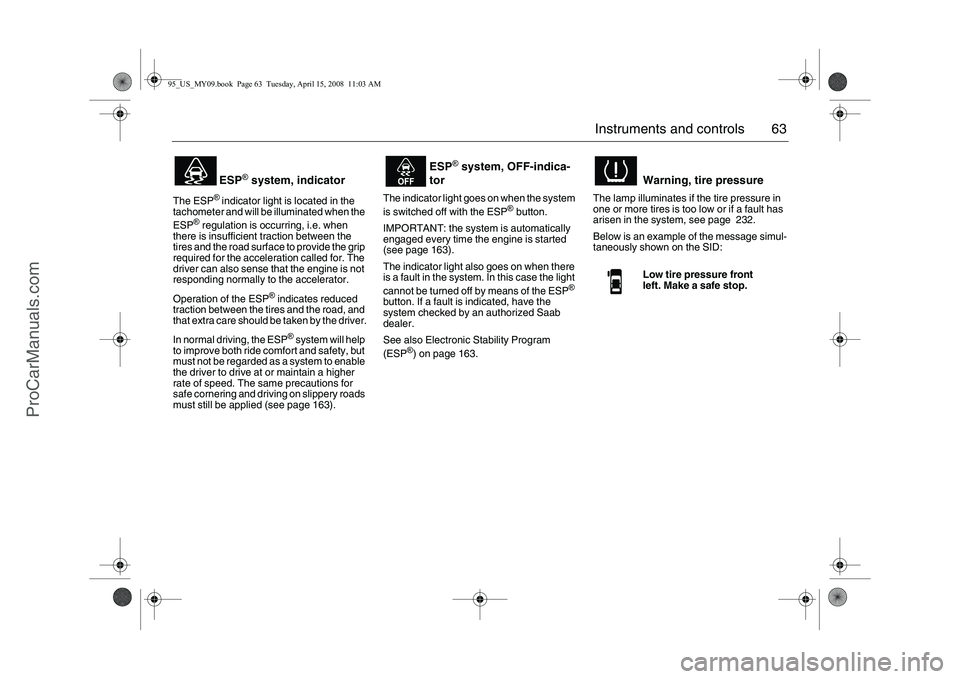
63 Instruments and controls
The ESP
® indicator light is located in the
tachometer and will be illuminated when the
ESP
® regulation is occurring, i.e. when
there is insufficient traction between the
tires and the road surface to provide the grip
required for the acceleration called for. The
driver can also sense that the engine is not
responding normally to the accelerator.
Operation of the ESP
® indicates reduced
traction between the tires and the road, and
that extra care should be taken by the driver.
In normal driving, the ESP
® system will help
to improve both ride comfort and safety, but
must not be regarded as a system to enable
the driver to drive at or maintain a higher
rate of speed. The same precautions for
safe cornering and driving on slippery roads
must still be applied (see page 163).The indicator light goes on when the system
is switched off with the ESP
® button.
IMPORTANT: the system is automatically
engaged every time the engine is started
(see page 163).
The indicator light also goes on when there
is a fault in the system. In this case the light
cannot be turned off by means of the ESP
®
button. If a fault is indicated, have the
system checked by an authorized Saab
dealer.
See also Electronic Stability Program
(ESP
®) on page 163.The lamp illuminates if the tire pressure in
one or more tires is too low or if a fault has
arisen in the system, see page 232.
Below is an example of the message simul-
taneously shown on the SID:
ESP
® system, indicator
ESP
® system, OFF-indica-
tor
Warning, tire pressureLow tire pressure front
left. Make a safe stop.
95_US_MY09.book Page 63 Tuesday, April 15, 2008 11:03 AM
ProCarManuals.com
Page 64 of 272

64 Instruments and controlsAutochecking of lights,
main instrument panel The above warning and indicator lights
should come on when the ignition is
switched on prior to starting. They should go
out after about 3 seconds.
The following lights light up until the engine
is started, presuming that no fault exists:
Oil pressure warning light .
Warning, charging .
InstrumentsTachometerThe tachometer indicates the engine speed
in thousands of revolutions per minute. The
needle may be allowed to enter the broken
red zone on the dial only for an instant.
A safety cut-out function (in the fuel system)
prevents the engine speed from exceeding
approximately 6,000 rpm.
Odometer and trip meter The odometer records the distance traveled
in miles on U.S. vehicles and on Canadian
vehicles the distance indicated is in kilome-
tres, and the trip meter in miles and tenths
(kilometres and tenths of kilometres on
Canadian vehicles). Reset button The reset button has two functions, deter-
mined by whether the ignition is ON or OFF.
When the ignition is ON, pressing the
button will reset the trip meter.
When the ignition is OFF, the display
lights up enabling you to read the odome-
ter and trip meter. Pressing the button a
second time will reset the trip meter.
IB4468
1 Cars with automatic transmission
IB3847
IB4157
95_US_MY09.book Page 64 Tuesday, April 15, 2008 11:03 AM
ProCarManuals.com
Page 66 of 272
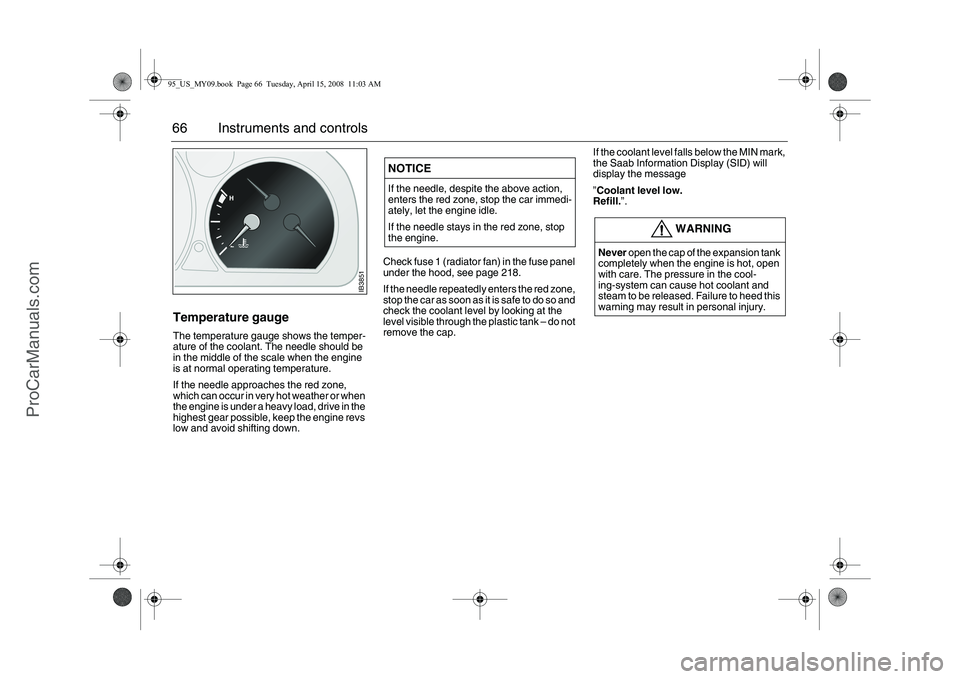
66 Instruments and controlsTemperature gauge The temperature gauge shows the temper-
ature of the coolant. The needle should be
in the middle of the scale when the engine
is at normal operating temperature.
If the needle approaches the red zone,
which can occur in very hot weather or when
the engine is under a heavy load, drive in the
highest gear possible, keep the engine revs
low and avoid shifting down.Check fuse 1 (radiator fan) in the fuse panel
under the hood, see page 218.
If the needle repeatedly enters the red zone,
stop the car as soon as it is safe to do so and
check the coolant level by looking at the
level visible through the plastic tank – do not
remove the cap. If the coolant level falls below the MIN mark,
the Saab Information Display (SID) will
display the message
”Coolant level low.
Refill.”.
NOTICEIf the needle, despite the above action,
enters the red zone, stop the car immedi-
ately, let the engine idle.
If the needle stays in the red zone, stop
the engine.
WARNING
Never open the cap of the expansion tank
completely when the engine is hot, open
with care. The pressure in the cool-
ing-system can cause hot coolant and
steam to be released. Failure to heed this
warning may result in personal injury.
IB3851
95_US_MY09.book Page 66 Tuesday, April 15, 2008 11:03 AM
ProCarManuals.com